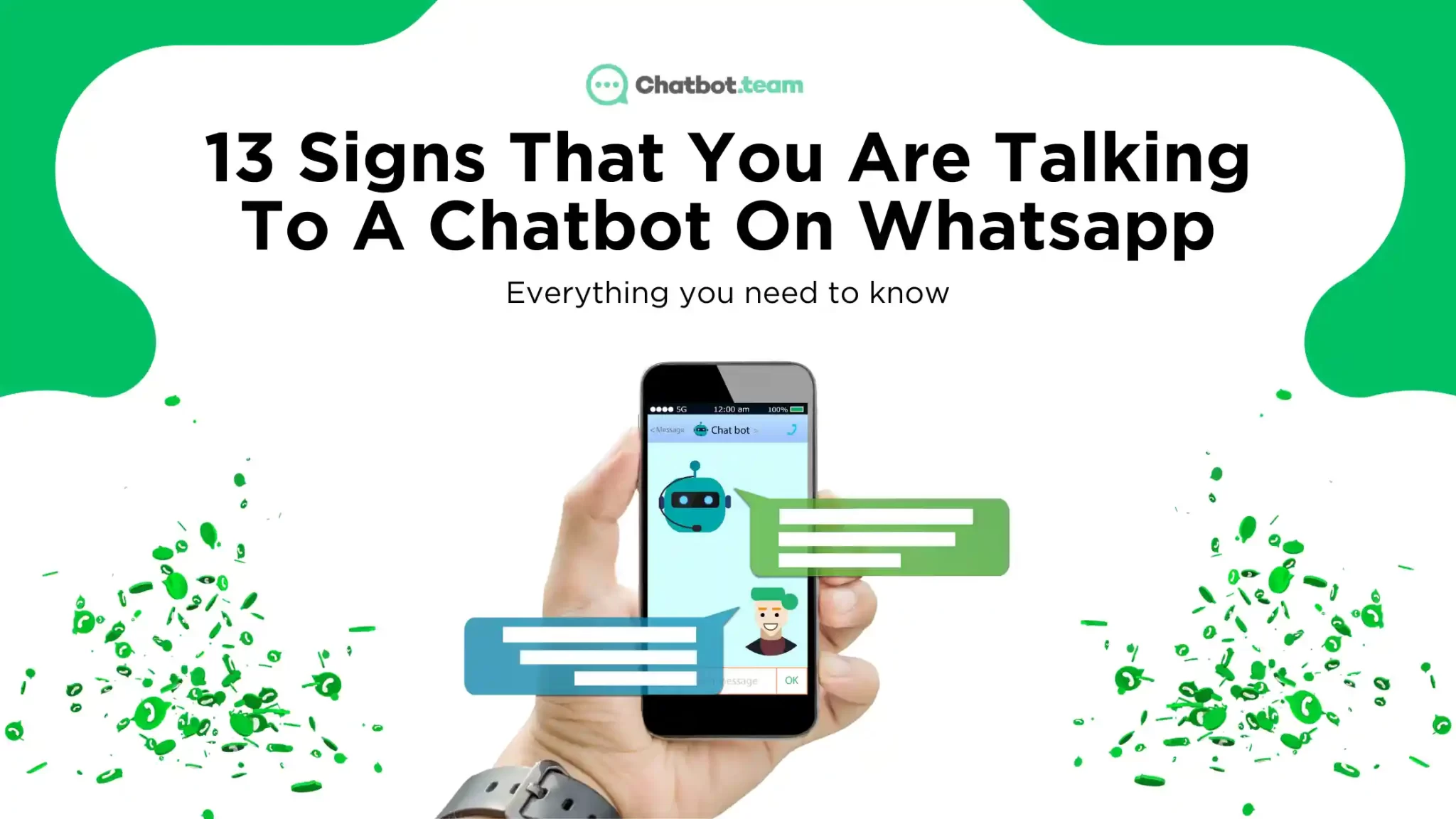Customer support, marketing, and sales are just a few of the uses for chatbots, which are growing more and more intelligent. As a user, we must be able to recognise whether we are talking to a human or interacting with a chatbot. However, sometimes it can be challenging to distinguish between a human and a chatbot. Chatbots have grown in popularity over the past few years across a variety of internet platforms, including messaging apps like WhatsApp. These computerised systems are made to converse with users, frequently in an effort to inform or help them.
What is a WhatsApp chatbot?
WhatsApp chatbot is an AI-driven conversational chatbot that promotes human-like contact via the WhatsApp chat interface between marketers and customers. For businesses using WhatsApp, it essentially automates the sales and customer care processes. It is also known as a WhatsApp bot and enables you to automate customer service and sales on WhatsApp. It can be characterised as a machine learning programme that aids brands in simulating human interactions.
Why is it important to recognize that you’re talking to a WhatsApp chatbot?
It is important to recognize as a user with whom we are talking, a human or a chatbot. There are many reasons for the same.
- Transparency & Trust: Trust in online interactions is increased by transparency. Users can believe that a chatbot’s responses are generated by a machine and aren’t meant to trick or manipulate them when the chatbot is transparent about its status as a bot. The discourse becomes more trustworthy and honest as a result of this clarity.
- Expectation Management: To control your expectations, ensure privacy and security, and make the most of the chatbot’s features, you must be aware that you are speaking with a WhatsApp chatbot. You can approach the conversation with a clear grasp of its benefits and drawbacks, which will result in a more positive and effective communication experience.
- Efficiency: Chatbots are created to respond quickly and automatically. If you are aware that you are speaking with a chatbot, you can modify your inquiries accordingly. As you won’t anticipate the in-depth or personalised responses that a human agent may deliver, this can save you time.
- Tailored Interaction: When you’re aware that you’re interacting with a chatbot, you can adjust your expectations. Chatbots excel at handling routine, frequently asked questions and tasks efficiently. Recognizing this can help you get quick and accurate answers to your queries without frustration.
- Miscommunication Prevention: Being aware that you are speaking with a chatbot enables you to customise your messages. While avoiding emotive or sophisticated statements that the chatbot might misunderstand, you can use simple, succinct language.
- Issue Escalation: Frequently, routine and simple tasks or questions are handled by chatbots. When you are aware that you are speaking with a chatbot, you can immediately escalate more complicated or urgent concerns to a human agent. By doing this, you can save time and make sure that your critical problems are swiftly addressed.
- Sensitive Data: It’s crucial to be aware that you’re conversing with a WhatsApp chatbot if you want to protect private information, retain your privacy, and control how you use the conversation. It enables you to have more control over the data you provide and makes sure you take the necessary precautions to preserve your privacy and data.
- Education: Recognizing when you’re speaking to a WhatsApp chatbot in the context of education is essential for sustaining ethical norms, preserving trust, and ensuring personalized learning. To give students and teachers a genuine and superior learning experience, educational institutions should be open about their usage of chatbots.
- Feedback Relevance: For effective communication, correct feedback, and helping to advance chatbot services, you must be aware when you are speaking to a WhatsApp chatbot. It improves user experience overall and helps to maintain a safe and effective digital environment.
- Empowerment: Being able to tell whether you’re speaking to a WhatsApp chatbot is crucial for empowerment since it fosters openness, trust, sensible decision-making, and smart resource management. Additionally, it aids users in controlling their expectations, avoiding potential scams, and learning about AI technology, ultimately enabling them to make wise decisions and interact with the internet successfully.
- User Experience: It’s critical to understand that you’re conversing with a WhatsApp chatbot in order to manage user expectations and deliver a more transparent and gratifying user experience. Users are able to make informed decisions about how to interact with the chatbot, and it aids businesses in providing more efficient and user-friendly services.
13 Signs that you are talking to a Chatbot On Whatsapp
In today’s digital age, it can be difficult to tell the difference between a real person and a chatbot. Chatbots are becoming increasingly sophisticated, and they are often used by businesses to provide customer service or support. However, there are a few telltale signs that you might be talking to a chatbot on WhatsApp.
1. Instant Replies
A bot replies instatly. Humans can only type 40 words per minute on average, therefore they require time to process communications. Nobody has the ability to type long paragraphs quickly. When the messages appear fast, it indicates that bot is replying.
2. Generic Responses
Bots carry out specified tasks. The direction that developers desire for conversations must be followed. Since AI is not sentient, all of its reactions are preprogrammed. Therefore a set answers are given when a bot replies.
3. Structured Messages
By using templates, bots construct sentences. Requests within the same category will result in the same responses because it often fills in the blanks. For instance, ChatGPT uses a similar phrase structure while only changing a few words.
4. Lack of Personalization
There is lack of personal touch when a bot responds. Its responses are predefined and generated according to the information fed.
5. Repetitive Phrases
By using templates, bots construct sentences. Requests within the same category will result in the same responses because it often fills in the blanks.
6. Inability to Handle Complex Queries
Contextual memory is how AI robots learn. To offer logical, complex responses during conversations, they make reference to prior information. As you add additional context, the quality of the responses rises as the bot gains knowledge from the exchange. Information won’t be retained by AI across sessions, though.
7. Scripted Conversations
Their responses are predefined. No matter what pointless request you enter, they’ll keep pointing you towards the same themes. Some are rather stealthy, but less advanced bots will just keep repeating the same canned, uninspired responses.
8. 24/7 Availability
Chatbots can respond around the clock. They quickly compose lengthy, complex output and perform pre-programmed tasks 24/7/365. Online platforms only become unresponsive if you have poor internet connectivity.
9. Error-Free Responses
Chatbots are programmed to follow pre-determined scripts, so their responses are often error-free. They will not make typos or grammatical errors, and they will always use correct spelling and punctuation.
10. Using Formal Language
Chatbots often use formal language, even in casual conversations. This is because they are programmed to be polite and professional.
11. Lack of Humor
Chatbots may not understand humor or sarcasm, so they may not respond to your jokes or witty remarks. This can make conversations with chatbots feel quite stiff and uninspired.
12. Inability to Adapt
Chatbots are not able to adapt to the flow of a conversation, so they may seem inflexible or unresponsive. If you try to change the topic or introduce new information, they may not be able to follow your lead.
13. Overly Positive Responses
Chatbots are often programmed to be overly positive, even in the face of negative feedback. This can be off-putting and make it difficult to have a genuine conversation.
How to effectively interact with chatbots?
Chatbot interaction has become more widespread across a range of online platforms, from customer assistance to virtual assistants. The following important advice can help you communicate with chatbots in a seamless and effective manner:
- Be Clear and Concise : Start a discussion with a chatbot by making a clear, succinct statement or asking a question. As chatbots frequently function better when they can understand your request quickly, try to avoid using excessively long words or needless details.
- Use relevant keywords : Use phrases and words that are pertinent to your search or request. This makes it easier for the chatbot to rapidly determine the goal of your message and deliver a more precise response.
- Follow prompt and options : A lot of chatbots offer consumers hints, choices, or menus to help them navigate the discussion. In order to expedite encounters and get you to the information or service you require, follow these prompts and choose selections as necessary.
- Break down Complex Queries : If your query or demand is complicated, think about dividing it into more manageable chunks. This makes it simpler for the chatbot to comprehend and efficiently respond to each part of your query.
- Provide Conext : It can be really beneficial to give your dialogue some context. If you’re asking about a specific order, for instance, add the order number or any other pertinent information. The chatbot can respond and offer aid more precisely when given context.
- Seek Clarification if needed : Don’t be afraid to ask for clarification if the chatbot gives you a response that you don’t really understand or that doesn’t seem pertinent. You can either reword your query to make it clearer or ask the chatbot to clarify it or provide more information.
- Know when to escalate : Even while chatbots can do a variety of jobs, they might not always be able to solve problems. Know when to escalate the conversation to a human agent or look for alternate support channels if you discover that the chatbot is unable to give you the assistance you require or if your problem is really complex or sensitive.
Conclusion
In conclusion, a great and secure chatting experience on WhatsApp depends on your ability to recognise the indicators that you are speaking to a chatbot. While chatbots are intended to assist and interact with consumers, it’s important to be aware of their presence to successfully manage expectations. These indicators, which include rapid responses, cliched greetings, recurrent responses, and others, are useful tools for users to distinguish between automated systems and human interactions.


